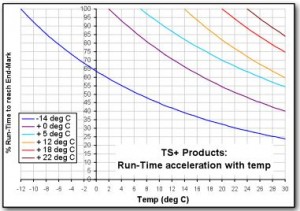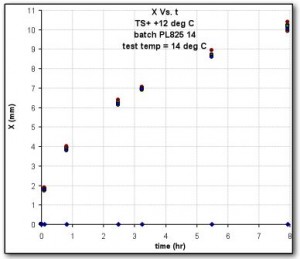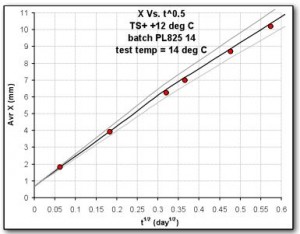Download PDF FAQ’s
FAQ’s
How does Timestrip Plus work?
A colored liquid dye housed in a blister is held adjacent to a specialized microporous membrane. Upon
squeezing the blister, the dye comes into contact with
the membrane. If the temperature of the product is
below the stated ‘stop’ temperature, the dye changes
state to solid form, and it is unable to move through
the membrane. If it rises above the threshold temperature, it changes to liquid form and moves at a
precise rate through the membrane. A scale printed
on the surface indicates the amount of time above
the threshold temperature.
Why do they have a start/threshold temperature and a ‘stop’ temperature?
The freezing point of a liquid is always lower that
its melting point. For example, water doesn’t freeze
at precisely 0˚C (32˚F), it freezes when the first ice
crystals form, which is typically lower than 0˚C. Its
melting point is precisely at 0˚C however. Timestrip
Plus™ works by diffusion of liquids that form crystals
and therefore the ‘stop’ temperature is lower than
that of the precise starting point. More technically, the
behavior of liquids in a membrane is different again
to normal freezing due to many other factors, all of
which we take into account when defining the products. We offer the best performance in this category
of products
Do I need to condition the products prior to activation?
No. Unlike other threshold temperature products,
Timestrip Plus™ does not require pre-conditioning.
You need to activate above the product’s threshold
temperature, as you cannot squeeze the blister in
solid form. Immediately after activation, stop the
process by placing below the ‘stop’ temperature. The
fastest way to do this is by placing in an environment
much colder than the stop temperature for a short
period of time
Do they have any special storage requirements before activation?
No, unlike other threshold temperature products, they
can be held at ambient temperatures.
Do they have a shelf-life?
Timestrip Plus™ shows no degradation in performance over time. We only provide a general guideline
of 2 years due to the pressure sensitive adhesive on
the bottom, which allows you to use the product as
an adhesive label. All standard adhesives have such
disclaimers regarding their shelf life.
Can Timestrip Plus indicate if a temperature has fallen below a certain point?
Timestrip Plus™ can only show ascending temperature excursions. We have other products that do this
type of descending temperature indication.
How accurate are they?
+/- 1˚Celsius for the temperature component and +/-
15% for the time component
What can they be used on?
Anything where elevated temperatures are an issue.
Common applications are frozen or chilled foods,
medicines, vaccines, blood products and adhesives.
Can you customize for us?
We have a growing range of standard products that
meet most cold chain requirements. As a general
rule, if you require more than 50,000 units, we can
customize the print, and in many cases, even the melt
temperature, although we have an extensive existing
range. There is a premium for this service. We can
also quote on custom carrier cards and backing labels,
if you need to provide instructions, add other languages, or a form to provide a permanent record.
Timestrip Plus™ compare with data loggers?
There are several fundamental differences, and in
some cases data loggers and Timestrip Plus™ can
be used in complementary ways to help monitor cold
chain integrity. Timestrip® also sells an exceptional
range of data loggers if more appropriate to your
requirement. Data loggers are expensive and typically
are designed to go on a large shipments, typically
need to be returned to be read, and to be used again
to justify the expense.
Timestrip Plus™ are inexpensive, single
use products that can be used on a large shipment,
but also on carton or even single dose level. Data
loggers provide a full history of temperature from the
time of activation. Timestrip Plus™ records how long
a product has been above its threshold temperature,
but cannot tell you when the breach or breaches occurred. Timestrip Plus™ is most often used to monitor and validate the “last-mile” of the cold chain where
the product gets closest to its eventual use. Data
loggers and other digital recorders are too expensive, and complicated to read and interpret. Timestrip
Plus™ give end users immediate visual messages
that can then form the basis of a “use/don’t use”
decision for temperature sensitive goods- even by
untrained recipients
What is the accuracy of the hour marks?
Every Timestrip Plus™ product is calibrated to a temperature of 2˚C above its stated threshold temperature. For example, Timestrip Plus™ 12˚C is calibrated
to a temperature of 14˚C. When the product breaches
its threshold temperature and is held at a constant
temperature(i.e. isotherm) of 14˚ C, it will reach the 1
Hour print mark within 1 Hr (+/- 15% in time).
What is the maximum run-time Timestrip Plus™ range can offer?
Timestrip Plus™ products use low viscous liquids and
inherently fast progressing. Typically the progression
rate of these liquids is roughly 15–25mm in 24 Hours
at room temperature. Timestrip Plus™ products feature a blister located on top of the product, reducing
the available window. Usually, the available run-out
window is limited to a maximum of 12mm which is
roughly correlated to a maximum of 24 Hours. This
value is liquid and temperature dependant thus can
change from product to product.
Why is there an activation window and a runout window?
Timestrip Plus™ products are implemented by activating the product at temperatures above the threshold and placing them below the stated ‘stop’ temperature, which stops the dye from moving throughout
the window. In order to provide a breach/no-breach
indicator there are 3 – 3.5 mm of progress from activation to the run out window. This distance correlates
to roughly 30–60 minutes and is strictly liquid and
temperature dependant ( it can change from product to product). Therefore the run-out window starts
showing breaches lasting 30-60 minutes depending
on the product needed.
What happens at elevated temperatures?
Due to the nature of liquids, higher temperatures
reduce Timestrip Plus™ dye viscosity. The correlated
result is faster/shorter run-times ( the progressing
colored dye will reach each printed time-mark sooner
than intended).
This graph represents the run-time acceleration with
temperature of different Timestrip Plus™ products.
For example, Timestrip Plus™ 0˚C is calibrated to
2˚C (pink line). When the product
is held at an isotherm of +2˚C it will reach each printmark (i.e. 1, 2, 4, 8 Hour, etc.) within the
exact time (i.e. 1, 2, 4, 8 Hour, etc.). However,
if the product is exposed to an isotherm of +10˚C
then it will reach each print-mark with only 75% of the
run-time. In other words, it will reach the 1 Hour timemark within 75% of 1 Hour (45 minutes), the 2 Hour
time-mark within 75% of 2 Hour (90 minutes), the 4
Hour time-mark within 75% of 4 Hour (180 minutes),
etc. At 23˚C the progressing front-line will reach each
print-mark with only 50% of the run-time, etc…


How are Timestrip Plus™ products evaluated for their time accuracy?
Timestrip Plus™ products are polymeric multi-layer
indicators. They are based on spontaneous lateral
wetting by a colored liquid inside a porous substrate
and not a chemical reaction. Each production batch
(7000 – 8000 products) undergo restrictive quality
control tests to validate its time accuracy.
This is conducted via a specially designed
computer vision software (TSCV) which analyzes
scanned photos of seven randomly-selected products from each batch (roughly 0.1% of the population). The photos are taken at different elapsed
times and the tested products are placed at their
designated temperature through the entire test period. The software automatically analyses the lateral
progress and the elapsed time of each product
tested and the data is presented numerically and
graphically in a specific file which is obviously batchrelated. This data is translated into a final release
report which is attached to the outgoing product
batches.
An example for such run-time accuracy analysis of
a specific production batch (Timestrip Plus™ 12 ˚C,
PL825-14) is given below. The first graph represents
the individual progress of the seven representative
products versus time. The second graph represents
the average progress of the seven tested products
versus the square root of time together with the
required progress (continues black line) and borders
of acceptance tolerance (two continues grey lines).
In this case the run-time accepted tolerance of the
averaged group is +/-15%.




What is a Timestrip®?
Timestrip® is a unique, patented timer that monitors
how long a product has been open or how long it has
been in use. Timestrip® is a single-use, disposable
product that can be produced to monitor time periods
ranging from 5 minutes to over a year
How does it work?
Timestrips® should be activated when the product is
first opened or used.
- Activate by squeezing the button flat.
- An activation line appears to show that the Timestrip® is working.
- Stick the Timestrip® on or near to the device it is monitoring.
- The liquid gradually moves across the white viewing window. Read how long the Timestrip® has been active by simply looking at the scale that is printed by the window.
- Dispose of the Timestrip® every time you change the device it is monitoring.
- Activate a new Timestrip® and attach it to the replacement device.
Specifications
- Dimensions:standard size is 19mm x 40mm.
- Approximately (3/4” x 1 1/2”)
- Time period:capability of monitoring time periods of between 5 minutes and 12 months.
- Temperature:Timestrips® are calibrated to monitor time at a specified average temperature selected from a range between -17˚C (1˚F) to +40˚C (104˚F).
- Accuracy: When used within the calibrated temperature range, accuracy is +/-10 to 15% depending on the model.
- Adhesive:can be supplied with a wide range of perm-peel or permanent adhesives on the underside of the Timestrip®, or with no adhesive at all.
- Packaging:can be supplied loose, in boxes, poly bags or custom packs.
How do I know if I activated the Timestrip®?
After squeezing the button flat a line will emerge in the
window to show that the Timestrip® is activated. If the
activation window is already red then do not use
Does it matter how it is oriented?
Orientation has no impact on the way it works.
Is the liquid safe?
Yes. We only use food-grade oils and non-toxic colourants in our formulation.
What happens if the liquid is ingested?
In the unlikely event that the liquid leaks from the
Timestrip®.and comes into contact with skin, simply
wash
with soap and water. If the liquid comes into contact
with eyes, rinse immediately with plenty of water and
seek medical advice
Are they waterproof?
No. Timestrips® should not be submerged in water,
but are splash-proof.
Can you use different colored liquids?
We are limited to using a red colourant in most
cases although certain products use blue.
Will the Timestrip® tell me when the product is no longer fresh?
Timestrip® only records the passage of time after
it is activated and therefore cannot guarantee the
quality or fitness for purpose of the product with
which it is used.
Is accuracy affected by temperature or altitude?
Timestrips® are accurate to within +/-10 to 15%
depending on the model, provided they
are used in line with the stated temperature.
If the product is stored at a higher than
intended temperature the Timestrip® will
advance at a faster rate, and vice versa at
lower temperatures. For detailed technical
information please contact us. Altitude does
not affect accuracy
What is the shelf life of a Timestrip®?
Timestrips® can be stored for a minimum of 3 years
and require no special storage conditions.
Can Timestrips be customized?
It is possible to customise the print, shape, dimensions and type of adhesive, subject to volumes, tooling costs and set-up charges.
